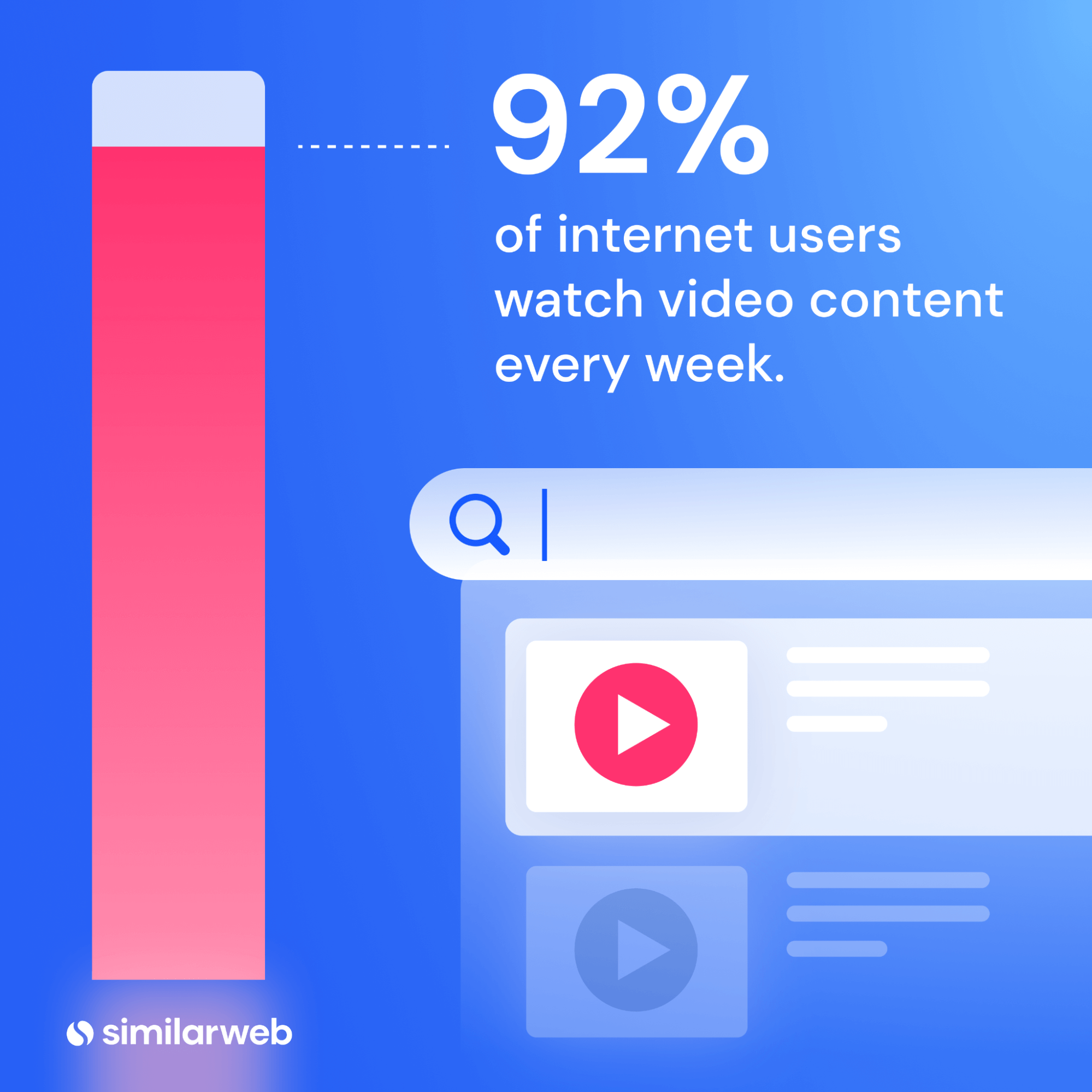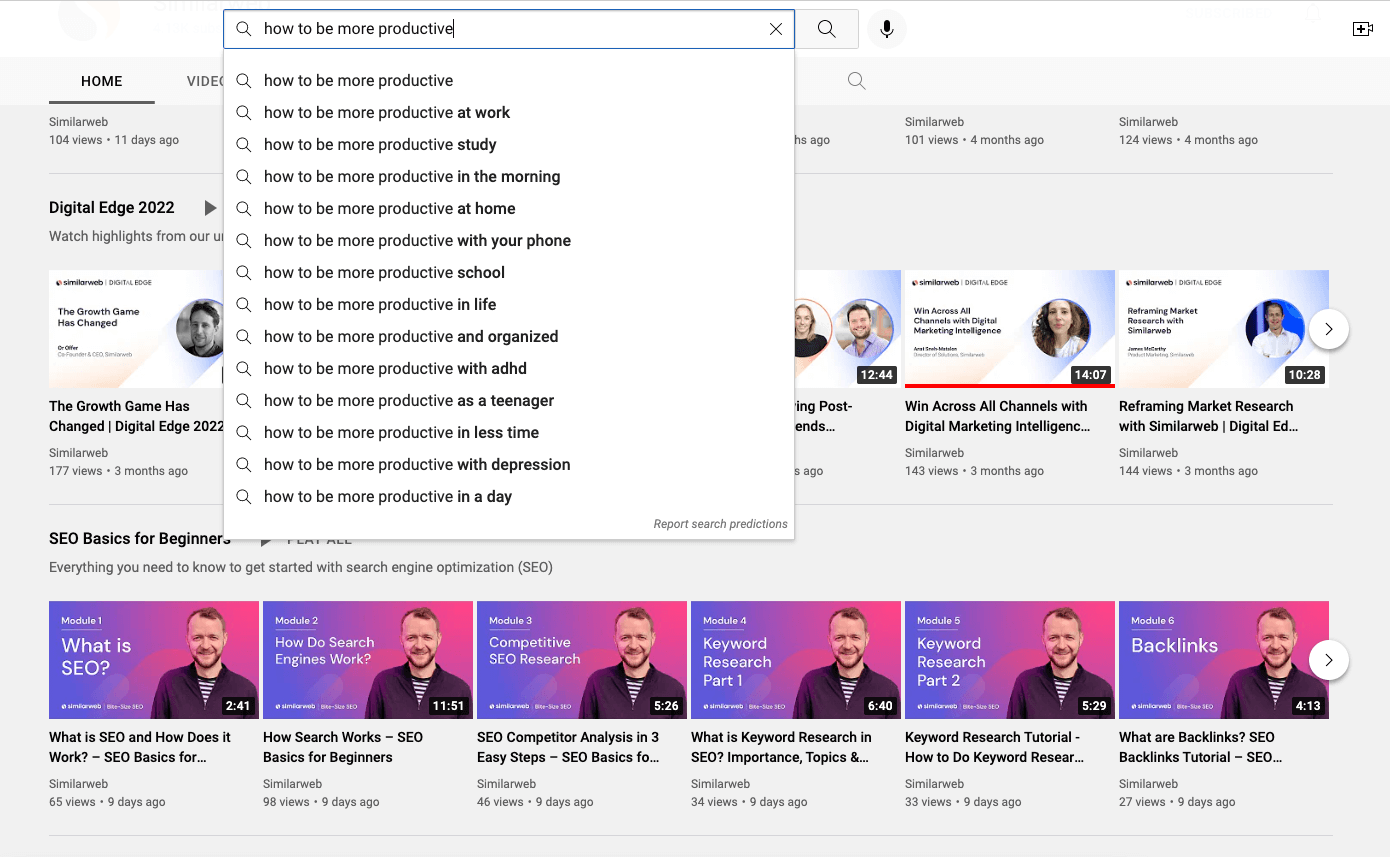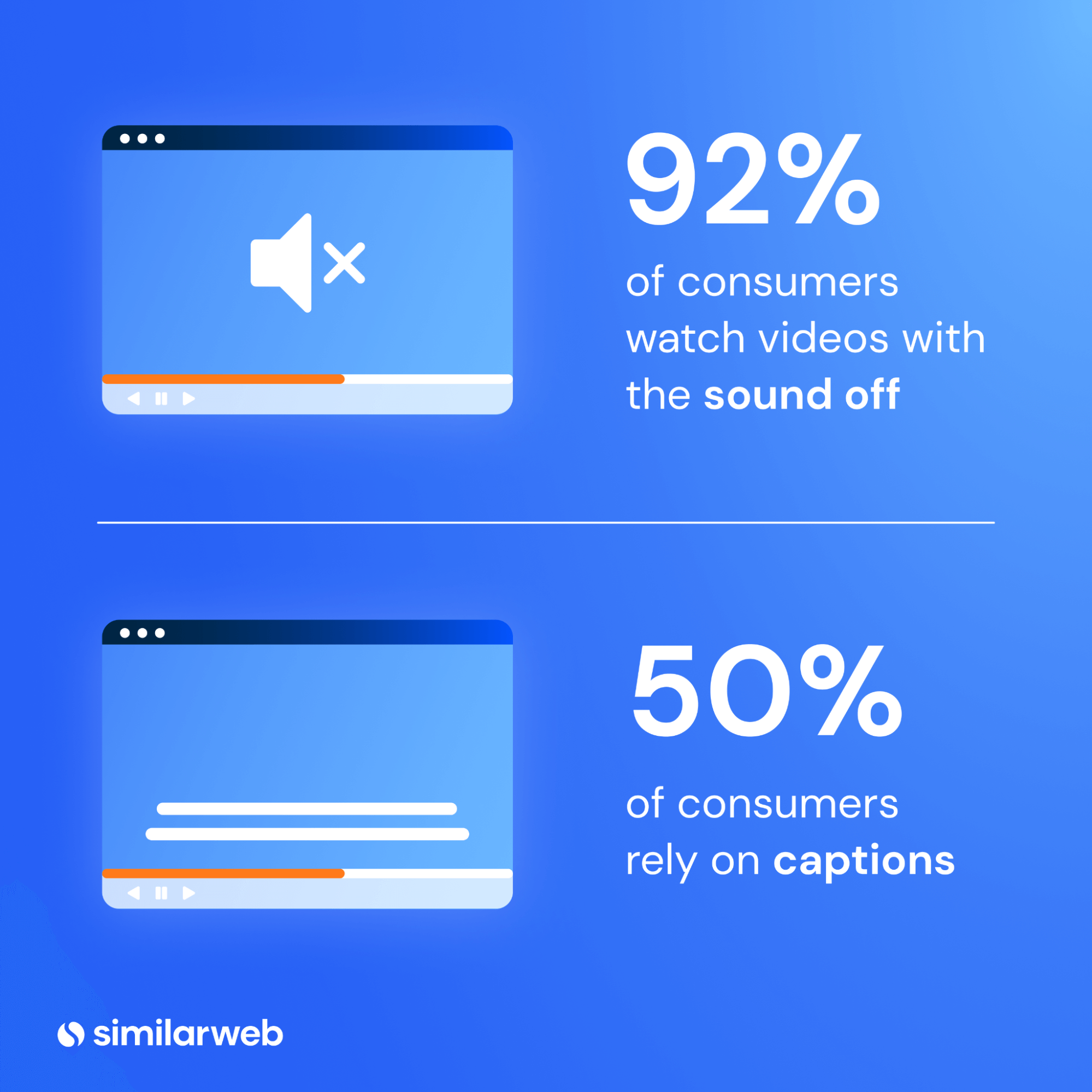 Marketing Intelligence
Marketing Intelligence
YouTube Keyword Research and Optimization Done Right

According to the Global State of Digital 2022 report, 92% of internet users watch video content every week. In America, 62% use YouTube daily. The platform receives 14.3 million monthly visits and has 1.7 billion unique visitors.
In addition to being a video content giant, YouTube is also the second-most popular search engine after Google.
That’s right. YouTube receives more monthly searches than Bing, Yahoo, AOL, and Ask.com combined. For today’s marketers, it’s quickly become an essential component of the overall digital strategy.
Despite the incredible user numbers, Fortune Lords claims that only 9% of small businesses in the US use YouTube to market themselves.
If that’s true, most SMBs are leaving the whole cake to the big brands. However, with so many viewers looking for content, the marketing potential is enormous. And considering YouTube is a search engine, businesses should use it to get found, increase visibility and show their expertise. The trick is to find your niche and optimize your video content accordingly, so it gets found by the right people.
In this article, we show you how to do keyword research for your YouTube channel and videos and provide tips on implementing them for the best results.
What is YouTube keyword research?
YouTube keyword research is the process of identifying which keywords people use to find video content on YouTube. SEOs and video marketers use it to optimize their YouTube content for maximum visibility and traffic. Finding the right keywords also helps target the right audience.
Keywords are at the core of SEO, no matter which search engine you optimize for. As a content creator, you implement them into your content similarly. However, there are some differences in how YouTube evaluates keywords compared to Google, which stems from a different general purpose. Unlike Google, YouTube wants to keep people on the platform and watch as many videos as they can digest in one session.
How do you find keywords for YouTube?
As with Google’s algorithm, YouTube SEO uses keywords in your content and metadata (your video’s title, tags, and description), to index your video correctly. There are many ways to maximize your presence in search, promotions, suggested videos, and ads — and to ensure your videos reach the right people.
The first step is to find out which keywords you should target. You want to identify what people type into the search bar when they intend to find the content you provide.
Here are some ideas for how to do that.
-
Use the YouTube autocomplete function
This trick is no secret. We’ve all done it on Google, and you can also do it on YouTube. Type your keyword – or part of it – into the search bar and let the search engine complete the phrase. You’ll get a bunch of ideas about what else people are searching for. Also, you’ll understand different sub-topics of your keyword and perhaps create separate videos for each one.
-
Check keywords from similar, popular videos
Go to your competitors’ YouTube channels and find the keywords that your competitors use in their most popular videos. Analyze their titles and descriptions to find additional keyword ideas. We’ll also tell you how you can really dig into competitors’ SEO and benchmark your performance against theirs, but that’s when we get to the heart of the research…
-
Do a video search on Google
Firstly, when you do a video search, you’ll find more similar videos that you can analyze for SEO. Secondly – and this is a little-known hack – when you scroll to the bottom of the SERP, you’ll find more suggestions. These are based on LSI keywords (Latent Semantic Index) – semantically related keywords.
-
Research YouTube tags
YouTube tags are a great way to target more keywords and tell YouTube what your video is about. SEO-savvy video creators add YouTube tags to improve their chances of getting found.
What does that mean for doing keyword research for YouTube videos? That’s right, explore the tags on your competitors’ videos and top-ranking videos. See what additional keywords others use to reach the same target audience.
To find tags on videos, you can search for “keywords” in the page source, or you can use tools like TubeRanker to extract the tags.
Further reading: Everything You Need to Know About YouTube Tags
-
Use keyword suggestion tools
You know the kind, right? The most popular is “Answer the public”. It shows you the questions people ask around a keyphrase and the long-tail keywords they use. Similar tools work according to the same concept; some provide more options, i.e., AlsoAsked. Most of these don’t offer ways to find YouTube keyword search volume.
-
Get YouTube Studio’s advanced stats
When you have enough views on your YouTube channel, you can get some search traffic data for your videos in the advanced option of YouTube Studio. This may include a list of keywords for YouTube traffic to your videos (it’s not available for all videos).
-
Use a YouTube keyword research tool
Naturally, you can conduct regular keyword research with your keyword research tool. However, most tools are geared towards Google search and receive their data from Google. They aren’t built to identify keywords for YouTube traffic.
To research YouTube keywords, you can use special tools designed to optimize YouTube channels and provide keyword data. The problem is that you’ll end up needing a keyword research tool for each platform – one for Google, one for YouTube, and one for Amazon.
So, how to find YouTube keywords without compromising or spreading yourself thin? Similarweb has a solution. Our YouTube keyword research tool makes it easy and efficient to conduct keyword analysis focused on a specific search engine.
How to do effective YouTube keyword research
Before we get into this, let’s discuss data quality. Your research can only be as good as the data it uses. You need accurate, reliable, and fresh data to get research results that reflect the search reality.
Unlike other tools that pull data only from Google and use data scraping methods, the Similarweb Digital Marketing Intelligence platform leverages verified user search queries on billions of keywords. We collect anonymous data from four different sources, including publicly available anonymous data from billions of websites, app and website owners and partners, and a contributory network of hundreds of global websites.
This means the insights derived from the Similarweb keyword research tool are based on Google data in combination with additional, verified search data. You get trustworthy and timely data and a genuine view of your competitors’ actual search traffic.
Use the Similarweb YouTube keyword generator
The first steps of keyword research are the same as when you optimize your blog content or web pages for specific keywords or keyword ideas related to what you want to solve or offer (be it a product or service). You determine the search terms you want the video content to be found for.
Here’s where Similarweb’s YouTube Keyword Generator tool comes in. In the keyword generator, you select the YouTube option among the three top search engines Google, Amazon, and YouTube.
Enter any relevant keyword and discover additional short-tail and long-tail keywords. The tool shows search volume, volume trend, and actual clicks.
Similarweb keyword generator offers an easy way to find YouTube search volume for your keywords. With the YouTube Keyword Generator, you can also examine from which countries the searchers are coming and expand your research beyond exact phrase matches to related keywords.
Apply filters to narrow down your research.
The tool allows you to refine your research by excluding or including selected terms. For example, you might want to see only tutorial videos for a certain subject. In this case, you can filter to display only keywords that include “how to”.
If that’s not the type of video content you are producing, you may choose to exclude the words “how to” and you’ll receive only the relevant keywords that don’t contain these two words. After you apply filters to include and exclude words, finding keywords for YouTube traffic becomes highly focused.
It’s a reliable way to get relevant keyword suggestions for your new videos and to help you reach new target audiences. It also allows you to clearly target search intent and direct your keywords to a more specific target audience.
Analyze and select keywords for your video SEO
Whether you found the keywords through the autocomplete function, extracted tags from your competitors’ videos, or came up with your own ideas, the next step is to plug them into the YouTube keyword generator.
The main metric to consider is search volume. Generally, you want to target a keyword with a high search volume as your main keyword for a video. Correlate the search volume with the number of clicks to ensure that people actually watch the videos. Also, pay attention that the search trend is not declining.
All secondary keywords should be related to the main topic, so it needs to be precise but not too specific and shows clear intent. For example, a tutorial should include “How to…” or “guide” or “tutorial”.
Examine traffic stats of long-tail keywords if they are relevant to your video content. They will make up your secondary keywords in the description and tags.
Go broad on keyword research
Don’t limit yourself to the YouTube keyword generator, though. Use the additional keyword research tools to dig deeper into keyword performance. As promised, here’s the deep dive I mentioned earlier.
- Conduct competitive analysis: Look into what’s generating traffic to your competitor’s websites, plus find new and trending keywords. Benchmark your traffic and engagement across all marketing channels, analyze your YouTube competitors, and discover growth opportunities based on what works best for your competitors. You can then use these insights to develop the most effective tactics for your YouTube marketing strategy.
- Find keyword gaps. See which keywords you are missing out on. Similarweb keyword gap tool measures the actual traffic keywords generate to a page. Contrary to other keyword gap tools that only measure ranking, you get a much better assessment of true keyword potential.
- Analyze keyword traffic. Get a clear understanding of the type of traffic a keyword generates. Use the tools to analyze organic and paid search separately, see where the traffic is coming from, which industries the traffic-receiving sites belong to, what’s trending, and more.
- Compare keywords side-by-side. With Similarweb’s keyword comparison feature, you can compare the metrics of up to five keywords side-by-side. This can be valuable for choosing the best primary keyword or identifying performance discrepancies between similar keywords. Remember, Google doesn’t differentiate between similar keywords but puts them in one bucket.
- Analyze mobile vs. desktop traffic. No matter which type of video, It’s critical that you consider mobile traffic for a keyword and create your videos with mobile in mind. Here’s a statistic that SEOs and digital marketers should keep in mind for video SEO: according to Statista, the time people spend watching video on mobile is double compared to watching time on desktop. People also watch more video content in one session on mobile.
YouTube SEO vs. Google SEO – differences and similarities
You’ve learned how to find and analyze potential keywords for your YouTube channel and videos, and it appears much like Google. But YouTube has a goal, and that’s not the same as other search engines. The video platform wants visitors to stay and watch more and more videos (with ads because that’s where the money comes from).
So let’s see how YouTube looks at content differently than Google. We’ve placed the main differences and similarities in a comparison table.
| Both | YouTube | ||
| What’s the purpose? | Find and provide credible, high-quality content. | Keep visitors on the platform by watching as much content as possible. | Deliver the best answers, solutions and information to a searcher’s query. |
| What are the ranking factors? | Keyword matches and authority. | Around 20 different ranking factors including watch time and retention. | Over 200 factors including optimized content, backlinks, and technical SEO. |
| How is authority established? | Amount of content and frequency of posting. | Number of subscribers, engagement. | E-A-T, keyword rankings, organic traffic. |
| How is engagement measured? | Number of views, click-throughs, comments, subscribers. | Time spent on page, bounce rate, CTR. | |
| How long does it take to rank? | A video can rank immediately. | It depends – usually, it will take days, weeks, or months to rank. |
Keep these in mind when optimizing your YouTube videos.
YouTube best practices for publishing your videos
YouTube Studio is the home of your video content, and that’s where the optimization happens. It’s where you add keywords in the right places, interact with your target audience and monetize your video content.
-
Rename the title of your video
Just as you would incorporate your target keyword in the title of a blog, rename your video files and final titles to include the primary keyword from your YouTube keyword research. Make it easy on YouTube to understand your content accurately. In addition, it’s super easy for you (your team) and viewers to identify what a particular video is about just by looking at the video title.
-
Optimize your video description
The official character limit for YouTube video descriptions is 5,000 characters. That’s a lot, and it’s OK to use the space, but remember, the viewer didn’t come to read an essay.
Your best approach is to provide a concise and compelling description of what the video is about and incorporate your target keywords. You may want to add links to other relevant content (e.g., your website, channel page, additional videos, blog posts, etc.). Always think about what action you want the viewer to take after watching, and include a straightforward CTA at the end of the description.
-
Create a transcript and subtitles
YouTube automatically transcribes your video to understand its content. You can add that or your own transcript to the page. Another way to support SEO and keep viewers on your video is to add subtitles. (For this, you need to use a .SRT file or directly enter a transcript so that it’s synchronized.)
Adding keywords in these places helps Youtube make sense of the message, the intent, and the targeted audience.
Viewers also benefit because it allows them to watch without sound and still understand the story. This is increasingly meaningful because the number of watchers viewing without sound is growing. The other advantage of doing this is that you can re-use the transcript as a blog post for your website.
-
Add YouTube tags
The big advantage of YouTube tags is that you can enter your entire list of keywords as tags. You don’t need to place keywords within the context of a written or spoken text. You can add plenty of synonyms or rephrase similar questions and strengthen your SEO position.
Find the tags in your YouTube studio under edit details and scroll till you get to “show more”. If you already have existing videos, you can easily add tags here.
-
Categorize your video
Under “Advanced settings”, choose the best-suited category for your video. This will group your video with similar content on YouTube, allowing it to get featured on the right playlists and reach your target audiences. You’ll increase the chances of your video getting more views.
-
Create a killer thumbnail
Your video thumbnail is the first impression viewers get when scrolling through the YouTube search results. Instead of using YouTube’s suggested thumbnail, create an image that will raise curiosity, provide a teaser and stand out visually.
A compelling thumbnail can help increase the click rate, and you’ll get more engagement. Remember, the filename should include the video title or at least the main keyword.
-
Build video series and playlists
When doing keyword research, try mapping your entire topic, not just a single video. Building a series of videos helps you gain topical authority. Also, by arranging them in playlists, you encourage your viewers to stay on your channel and watch more videos. More view time improves your ranking.
To YouTube and beyond
YouTube’s potential for content marketing, syndication, and promotion is growing with its popularity as a search engine and content platform.
Optimizing video content for the right terms to get found by the right audience is no longer nice to have. Keyword-research-based SEO is essential for video content on YouTube. It helps to build awareness of your business, products, and services and reach new audiences as you identify new, relevant keyword terms.
Following the tips outlined in this article, from keyword research and optimization to competitive analysis and video descriptions, will ensure you successfully use the platform, now and in the future.
Similarweb can help you to uncover rich insights and video keywords that can drive traffic and support your YouTube content strategy.
FAQs
How can I find the best keywords for YouTube?
The best way to find keywords for your Youtube video is by using a keyword generator for YouTube. The tool will show you what people search for on YouTube and which keywords drive the most traffic on YouTube.
How do I conduct keyword research for YouTube?
First, you need to define the topic and terms or phrases that describe the topic. Next, you’ll examine which keywords people use to find similar content. Use YouTube autocomplete, investigate competitors’ videos and use a YouTube keyword generator to create a list of keywords. You can do a complete keyword analysis to pinpoint your best options.
What are the best keywords for YouTube?
A good keyword for Youtube defines the topic of the video and identifies the search intent. Often long-tail keywords can work better for videos because they make it easier for the search engine and the searcher to understand the message and intent.
The #1 keyword research tool
Give it a try or talk to our marketing team — don’t worry, it’s free!


















